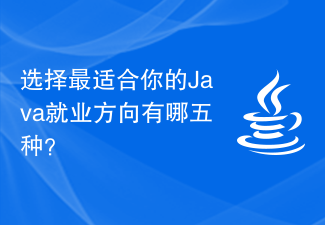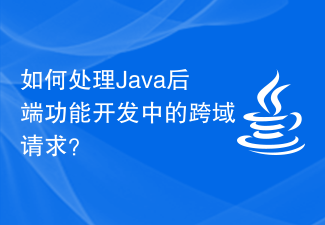 Backend Development
Backend Development PHP Tutorial
PHP Tutorial Java backend development: API SOAP service management using Java Apache Axis
Java backend development: API SOAP service management using Java Apache AxisJava backend development: API SOAP service management using Java Apache Axis
In today's software development, APIs are inevitable. API provides an interface for interaction between different applications. An API is a way of expressing interfaces that allows developers to more easily integrate and extend different applications and services. SOAP (Simple Object Access Protocol) is an XML-based communication protocol that allows applications to exchange information through the HTTP protocol and supports cross-language and platform communication. Apache Axis is a Java SOAP framework developed by the Apache Foundation for building and deploying SOAP servers and clients.
In this article, we will discuss how to perform API management using the Apache Axis framework. We will explain it from the following aspects:
- Install Apache Axis
- Build SOAP Web service
- Manage SOAP Web service
- Call SOAP Web Service
- Install Apache Axis
First, we need to install Apache Axis. Apache Axis provides two installation methods:
- Download and unzip the Apache Axis binary
- In a Java application, use Apache Maven or Gradle to add the Apache Axis dependency
If you choose to download and unpack Apache Axis, you can complete the installation by following these steps:
- Visit the Apache Axis download page https://axis.apache.org/axis2/java/ core/download.cgi, select "Binary Distribution" to download.
- Extract the downloaded zip file to your computer.
- Environment variable settings: Set the AXIS2_HOME variable to point to the folder where Axis2 is installed.
- Building a SOAP Web Service
Once Axis2 has been installed and configured, we can start building our API. The specific steps are as follows:
- Open your Java IDE (such as Eclipse) and create a new Java Web project.
- Create a new package in the src folder created by the project, naming method: com.example.api, and then create a new Java class file in the package and name it CalculatorService.
- Build the API: Build a simple API in the CalculatorService class as follows:
package com.example.api;
public class CalculatorService {
public int add(int x, int y) {
return x + y;
}
public int substract(int x, int y) {
return x - y;
}
}- Manage SOAP Web Service
Created After the web service, we can perform some management operations. For example, we need to pay attention to API deployment, service port configuration, etc. We can configure it in the services.xml file in the WEB-INF directory under the project root directory. The specific steps are as follows:
- Create the center "services.xml" file: Create the services.xml file in the WEB-INF directory under the root directory. This file indicates the name of the service resource file that the application contains to be published.
- Edit Center "services.xml" file: Configure web service information, including service name and its corresponding interface, port, etc. The following is a sample service:
<serviceGroup>
<service>
<parameter name="ServiceClass" locked="false">com.example.api.CalculatorService</parameter>
<parameter name="ServiceName" locked="false">CalculatorService</parameter>
<parameter name="XMLValidator" locked="false">org.apache.axis2.jaxws.description.impl.JAXWSAxisServiceBuilder</parameter>
<operation>
<parameter name="addOperation" locked="false">
<messageReceiver class="org.apache.axis2.jaxws.server.JAXWSMessageReceiver" />
</parameter>
<parameter name="subOperation" locked="false">
<messageReceiver class="org.apache.axis2.jaxws.server.JAXWSMessageReceiver" />
</parameter>
</operation>
<module ref="soapmonitor" />
</service>
</serviceGroup>- Call SOAP Web Service
Finally, we can call our API through the client program. The following is a simple Java client program that calls the Add method in the CalculatorService interface.
import org.apache.axis2.AxisFault;
import org.apache.axis2.addressing.EndpointReference;
import org.apache.axis2.client.Options;
import org.apache.axis2.rpc.client.RPCServiceClient;
import org.apache.axis2.transport.http.HTTPConstants;
import javax.xml.namespace.QName;
public class JavaWebServiceClient {
public static void main(String[] args) {
try {
EndpointReference epr = new EndpointReference("http://localhost:8080/axis2/services/CalculatorService");
RPCServiceClient serviceClient = new RPCServiceClient();
Options options = serviceClient.getOptions();
options.setProperty(HTTPConstants.CHUNKED, "false");
QName name = new QName("http://api.example.com", "add");
Object[] params = new Object[] {21, 45};
Class[] paramTypes = new Class[] { Integer.class, Integer.class };
Object[] response = serviceClient.invokeBlocking(name, params, paramTypes);
if (response.length > 0 && response[0] != null) {
System.out.println("Result: " + response[0]);
}
} catch (AxisFault axisFault) {
axisFault.printStackTrace();
}
}
}This article provides some basic knowledge about SOAP Web service development using the Java Apache Axis framework and introduces you to how to build, deploy and call a simple SOAP Web service. SOAP web services are an important part of building API-based enterprise applications. By using the Apache Axis framework, you can quickly and easily develop efficient SOAP web service applications.
The above is the detailed content of Java backend development: API SOAP service management using Java Apache Axis. For more information, please follow other related articles on the PHP Chinese website!
 选择最适合你的Java就业方向有哪五种?Jan 30, 2024 am 10:35 AM
选择最适合你的Java就业方向有哪五种?Jan 30, 2024 am 10:35 AM从事Java行业的五个就业方向,你适合哪一个?Java作为一种广泛应用于软件开发领域的编程语言,一直以来都备受青睐。由于其强大的跨平台性和丰富的开发框架,Java开发人员在各行各业中都有着广泛的就业机会。在Java行业中,有五个主要的就业方向,包括JavaWeb开发、移动应用开发、大数据开发、嵌入式开发和云计算开发。每个方向都有其特点和优势,下面将对这五个方
 Java后端开发:使用Akka HTTP构建反应式APIJun 17, 2023 am 11:09 AM
Java后端开发:使用Akka HTTP构建反应式APIJun 17, 2023 am 11:09 AM在当今Web开发中,反应式编程正变得越来越重要。AkkaHTTP是一种基于Akka的高性能HTTP框架,适用于构建反应式的REST风格的API。本文将介绍如何使用AkkaHTTP构建反应式API,同时提供一些实用的示例。下面就让我们开始吧!为什么选择AkkaHTTP在开发反应式API时,选择合适的框架非常重要。AkkaHTTP是一个非常好的选择,因为
 如何处理Java后端功能开发中的跨域请求?Aug 05, 2023 am 09:40 AM
如何处理Java后端功能开发中的跨域请求?Aug 05, 2023 am 09:40 AM如何处理Java后端功能开发中的跨域请求?在前后端分离的开发模式下,前端通过JavaScript发送请求到后端API接口获取数据是非常常见的场景。然而,由于浏览器的同源策略,存在着跨域请求的限制。跨域请求是指前端页面通过AJAX等方式请求不同域名、不同端口或不同协议的服务器。本文将介绍一种处理Java后端功能开发中跨域请求的常用方法,并附带代码示例。解决跨域
 如何解决Java后端功能开发中的数据库事务问题?Aug 04, 2023 pm 07:45 PM
如何解决Java后端功能开发中的数据库事务问题?Aug 04, 2023 pm 07:45 PM如何解决Java后端功能开发中的数据库事务问题?在Java后端功能开发中,涉及到数据库操作的功能很常见。而在数据库操作中,事务是一项非常重要的概念。事务是指由一系列数据库操作组成的逻辑单元,它要么完全执行,要么完全不执行。在实际应用中,我们经常需要确保一组相关的数据库操作要么全部成功执行,要么全部回滚,以保持数据的一致性和可靠性。那么,如何在Java后端开发
 Java后端开发:构建安全的RESTful APIJun 17, 2023 am 08:31 AM
Java后端开发:构建安全的RESTful APIJun 17, 2023 am 08:31 AM随着互联网技术的不断发展,开发和设计RESTfulAPI已成为一项至关重要的工作。RESTfulAPI提供了一种简单、轻便、灵活且可靠的机制用于不同服务之间的交互。与此同时,构建安全的RESTfulAPI也变得越来越重要。在本文中,我们将探讨Java后端开发中如何构建安全的RESTfulAPI。一、认识RESTfulAPIRESTfulAPI是一
 如何在Java后端功能开发中实现数据持久化?Aug 07, 2023 am 10:21 AM
如何在Java后端功能开发中实现数据持久化?Aug 07, 2023 am 10:21 AM如何在Java后端功能开发中实现数据持久化?随着互联网的快速发展,数据成为了一个组织和企业不可忽视的核心资产。在Java后端开发中,实现数据持久化是一项重要的任务。本文将介绍几种常见的数据持久化方式,并使用代码示例来展示如何在Java中实现数据持久化。一、关系型数据库关系型数据库是最常见的数据持久化方式之一。在Java中,我们可以使用JDBC(JavaDa
 如何在Java后端功能开发中实现搜索功能?Aug 05, 2023 am 11:09 AM
如何在Java后端功能开发中实现搜索功能?Aug 05, 2023 am 11:09 AM如何在Java后端功能开发中实现搜索功能?搜索功能是现代应用程序中必不可少的一个重要功能。无论是在电商平台中搜索商品,还是在社交媒体中搜索朋友,搜索功能都为用户提供了便捷和高效的信息获取方式。在Java后端开发中,我们可以利用各种技术和库来实现搜索功能。本文将介绍一种常用的实现搜索功能的方法,并以Java语言为例给出代码示例。在Java后端开发中,我们通常会
 如何处理Java后端功能开发中的异常情况?Aug 06, 2023 pm 04:06 PM
如何处理Java后端功能开发中的异常情况?Aug 06, 2023 pm 04:06 PM如何处理Java后端功能开发中的异常情况?在Java后端开发中,处理异常情况是一项非常重要的任务。异常可能出现在运行时,比如空指针异常、数组越界异常等,也可能是业务逻辑上的异常,比如找不到资源、权限不足等。恰当地处理这些异常,不仅能提高代码的稳定性和可靠性,还能提高代码的可维护性和可读性。本篇文章将介绍如何合理处理Java后端开发中的异常情况,并给出相应的代


Hot AI Tools

Undresser.AI Undress
AI-powered app for creating realistic nude photos

AI Clothes Remover
Online AI tool for removing clothes from photos.

Undress AI Tool
Undress images for free

Clothoff.io
AI clothes remover

AI Hentai Generator
Generate AI Hentai for free.

Hot Article

Hot Tools

SublimeText3 Chinese version
Chinese version, very easy to use

mPDF
mPDF is a PHP library that can generate PDF files from UTF-8 encoded HTML. The original author, Ian Back, wrote mPDF to output PDF files "on the fly" from his website and handle different languages. It is slower than original scripts like HTML2FPDF and produces larger files when using Unicode fonts, but supports CSS styles etc. and has a lot of enhancements. Supports almost all languages, including RTL (Arabic and Hebrew) and CJK (Chinese, Japanese and Korean). Supports nested block-level elements (such as P, DIV),

SublimeText3 Linux new version
SublimeText3 Linux latest version

MantisBT
Mantis is an easy-to-deploy web-based defect tracking tool designed to aid in product defect tracking. It requires PHP, MySQL and a web server. Check out our demo and hosting services.

SAP NetWeaver Server Adapter for Eclipse
Integrate Eclipse with SAP NetWeaver application server.





